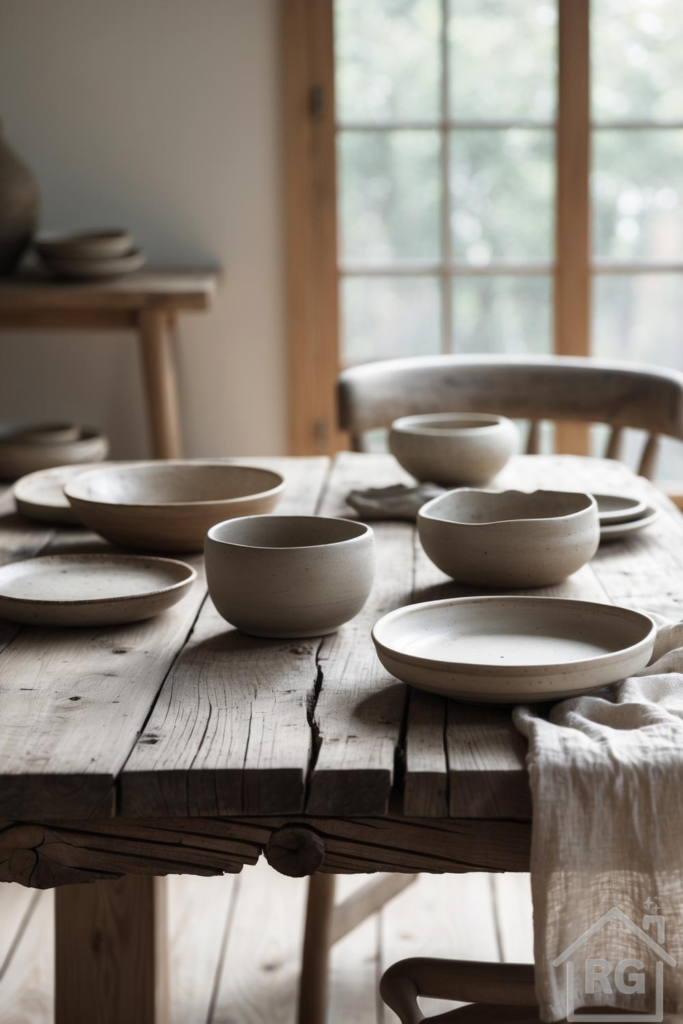
The image captures a moment of quiet beauty, a perfect embodiment of the Japanese philosophy of Wabi-Sabi – finding beauty in imperfection, impermanence, and the natural cycle of growth and decay. This aesthetic, centered around authenticity, natural materials, and a muted palette, offers a serene escape from the clamor of modern life.
Achieving this look in your own dining space involves focusing on texture, natural elements, and a mindful approach to selecting objects. This guide will walk you through creating a similar atmosphere, focusing on the key elements seen: rustic wood, natural stoneware, and soft textiles.
The Soul of the Space: The Rustic Wooden Table
The undeniable centerpiece of this Wabi-Sabi setting is the rustic wooden table. Its deeply grained surface, marked by time and use with cracks and knots, tells a story. This isn’t about flawless finishes; it’s about character and authenticity.
Choosing Your Table
Look for tables made from reclaimed wood, old barn wood, or thick, minimally processed planks. The more texture, the better. Visible joinery, slight unevenness, and a matte or oiled finish enhance the effect. Avoid high-gloss varnishes or overly perfect surfaces.
Sourcing Options
Flea markets, antique shops, salvage yards, and specialized furniture makers focusing on reclaimed materials are excellent places to search. Alternatively, consider DIY options using scaffold boards or reclaimed timber if you’re handy.
Table Alternatives
If a full rustic table isn’t feasible, consider a live-edge wood tabletop placed on simpler legs, or even a sturdy, simple wooden table that you allow to age naturally. The key is the tactile quality and visible grain of the wood.
Care and Maintenance
Embrace the aging process. Minor scratches or water marks become part of the table’s history. Use natural beeswax or oil finishes for protection, reapplying occasionally. Avoid harsh chemical cleaners.
Earthy Elegance: The Beauty of Stoneware Ceramics
Complementing the rustic wood are the simple, earthy stoneware ceramics. Their forms are organic, their glazes often matte or subtly textured, reflecting the light softly.
Selecting Pieces
Opt for stoneware or earthenware with a handcrafted feel. Look for slight irregularities in shape, thickness, or glaze application – these are hallmarks of Wabi-Sabi. Choose bowls and plates in a muted, neutral palette: think beige, cream, stone grey, soft taupe, or earthy brown, mirroring the colors in the image (#D1C7B9, #EAE4DA).
Texture and Finish
Matte or satin finishes work best. Avoid bright, glossy glazes. Speckled glazes, unglazed rims, or subtle variations in color add depth and interest.
Mixing and Matching
Don’t feel obligated to buy a perfectly matched set. Combining pieces from different artisans or lines, as long as they share a similar aesthetic and color family, enhances the organic, collected-over-time feel.
Where to Find Them
Seek out local ceramic artists, pottery studios, artisan markets, or online platforms like Etsy. Many mainstream retailers also offer stoneware collections with a rustic aesthetic.
Softening the Scene: Natural Textiles
A simple, rumpled linen napkin adds a crucial layer of softness and texture, contrasting beautifully with the hard surfaces of wood and ceramic.
Material Choice
Linen is ideal due to its natural texture, beautiful drape, and tendency to look even better slightly wrinkled. Washed cotton or hemp are also good alternatives. Stick to natural fibers.
Color Palette
Keep textiles within the neutral, earthy palette – off-white, beige, oatmeal, or soft grey. This maintains the serene and cohesive feel.
Simplicity in Design
Avoid elaborate patterns or fussy details. A simple hemstitch or a raw edge can add subtle interest. Consider using linen placemats or a simple runner instead of a full tablecloth to allow the beauty of the wood to show through.
Setting the Atmosphere: Light and Simplicity
The image benefits immensely from soft, natural light filtering through the window. This highlights the textures and creates a peaceful mood.
Harnessing Light
Position your dining table near a window if possible. Use sheer curtains or leave windows bare to maximize natural light. In the evenings, opt for soft, warm lighting – candles (in simple holders), or dimmable overhead lights with warm bulbs.
Embracing Minimalism
Wabi-Sabi embraces simplicity and avoids clutter. Let the chosen objects breathe. Use negative space effectively on the tabletop. Resist the urge to over-decorate. The focus should be on the inherent beauty of the materials themselves.
Complementary Elements
The partially visible wooden chair echoes the material of the table. A simple ceramic vase in the background adds height without distraction. Keep surrounding decor minimal and aligned with the natural, textured theme.
Bringing it All Together: Styling Your Wabi-Sabi Table
- Arrangement: Place ceramics informally. Stack plates slightly off-center, group bowls naturally. It shouldn’t look rigidly staged.
- Embrace Asymmetry: Perfect symmetry can feel sterile. Allow for a more organic, balanced asymmetry in your arrangement.
- Incorporate Nature: Small, subtle natural elements like stone coasters (as hinted in the image), a single stem in a simple vase, or a small wooden serving board can enhance the connection to nature.
Beyond the Table: Extending the Aesthetic
To create a truly immersive Wabi-Sabi dining room, consider:
- Walls: Muted, neutral paint colors (off-white, soft grey, beige) or natural finishes like lime wash or clay plaster.
- Flooring: Natural wood floors, stone tiles, or simple, natural fiber rugs.
- Window Treatments: Simple linen or cotton curtains, or wooden blinds.
- Overall Decluttering: Maintain a sense of calm spaciousness by keeping the room free of unnecessary items.
Conclusion: Finding Beauty in Simplicity
Creating a Wabi-Sabi inspired dining setting is less about buying specific items and more about adopting a mindset. It’s about appreciating the beauty in natural materials, the character of imperfection, and the tranquility of simplicity.
By focusing on textured wood, earthy stoneware, natural textiles, and soft light, you can cultivate a dining space that feels authentic, calming, and deeply connected to the natural world. Start small – perhaps by introducing some stoneware bowls or a linen runner – and gradually build a space that resonates with quiet beauty. Explore your local artisans and vintage shops, and enjoy the process of curating a space that tells its own unique, imperfect story.
